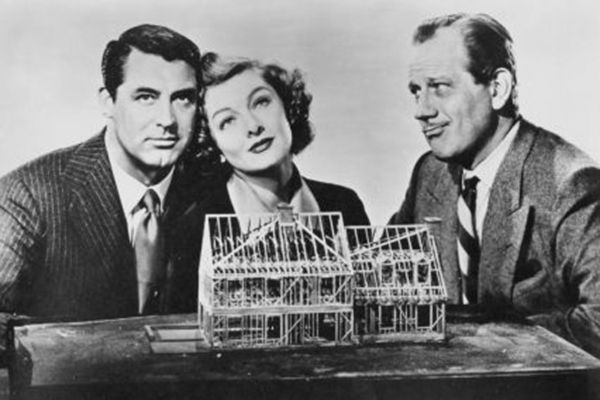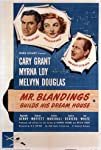Eye For Film >> Movies >> Mr. Blandings Builds His Dream House (1948) Film Review
Mr. Blandings Builds His Dream House
Reviewed by: Andrew Robertson

There's so much to commend about Mr Blandings Builds His Dream House in terms of those involved that it can become difficult to talk about it as a film itself. That its production involved the legendary David O Selznick, screenwriting partnership Norman Panama and Melvin Frank, even that it was remade as Tom Hanks vehicle The Money Pit and Ice Cube vehicle Are We Done Yet? I say re-made, this was based on a novel by Eric Hodgins and indeed a copy of it appears at the end. There's also the cast - Myrna Loy as the wife of Cary Grant, the eponymous Mr Blandings - even in a supporting role the double Oscar-winner Melvyn Douglas.
It's his Bill Cole that provides the introductory voiceover over what I suppose is only archive footage because it's from 1948. Contemporary footage, and comic timing. Manhattan, New York, United States, 8 million souls and change in crisp black and white. James Wong How on cinematography (another double Oscar-winner), ably managing a wide mixture of sequences, including visions of the house yet to be. HC Potter in the director's chair is possibly most famous for this. To suggest that there are no new ideas in Hollywood isn't new, of course - Potter also helmed the 1950 sequel to the Oscar-winning Mrs Miniver.

The temptation is to talk about what's behind the screen, as said, but that misses a comedy that still holds up. There's definitely era-borne difficulty, Louise Beavers is vital as the family's housekeeper Gussie, indeed - avoiding spoilers for a 73 year old film - she is not only part of the happy ending but she's almost comically under-rewarded for it. Opportunities for women of colour in film are still limited, here in a comedy she's not quite the comic relief but still a stock, and potentially discomfiting, character.
Other parts fare better. Part of the inclination towards the dream house is in the lack of space in a Manhattan apartment. There are plenty of visual and auditory jokes to underscore the importance of closet space, shared bathroom woes, but a sequence that tracks Mr Blandings from bedroom to kitchen to sup his orange juice and bring Mrs Blandings her morning coffee is a masterpiece of economies of motion. Each step (and over) tells us something.
The notion of transferable skills provides much of the comedy. Even now, UK viewers familiar with Channel 4's Grand Designs will recognise that success in advertising does not mean there will be equivalent outcomes managing a building site. The sums involved are hard to grasp but it's almost refreshing to see Manhattan living where the constraints of commuting and affordability actually matter.
The construction itself is fraught. There are issues with mortar and mortgages, water in the wrong place and not where expected. At one point a well gets to 130 feet. Adjusting for inflation in 2021 that's that's 472 yards and 31 inches. The past is a foreign country and all that, but America is sometimes triply so.
You don't need a solid grounding or even a loose foundation in house-building. The film does its best to illustrate why that might matter, but the comedy doesn't rely on it. It might help you to know that a lintel's the horizontal bit that goes over a door, a lalley is the vertical bit (often concrete) that holds up a horizonal cross-member like a lintel, and a 'rabbet' or 'rebate' is a process of stepping that secures a horizontal element (like a lintel) to a vertical element (like a lalley) to prevent movement. It would certainly have helped the Blandings...
There are the perils of moving - not just navigating to a new house, but reorganising, redecorating, reading train timetables. There's also the process of settling in, and settling down. I don't know if you've ever experienced buyer's remorse before you've received your confirmation email but anyone who's made a big decision can empathise with Mr Blanding's frustration, even without Cary Grant's countenance and the woe behind that hole in his chin.
This isn't quite the paean to small town living that Jimmy Stewart achieved in Bedford Falls. Indeed, this is almost as much about the emerging phenomenon of suburbia and dormitory towns. Admittedly one distorted even in the late Forties by American perspectives on distance. An hour into New York by car and from a neighbouring state sounds alien now, and I don't know how it would have played in pre-Beeching British cinemas. I'd put an asterisk on that train reference but if you don't get it even starting an hour earlier is no remedy.
Again though, the temptation is to talk about things other than what's on screen. Decades later, near three-quarters of a century, context is important. Without though, this is an amiable and still-relatable comedy of errors. Hubris, debris, jealousy ex-libris, few sources of comedy are left unplumbed, though some rooms are. There's even things falling over, which is as funny now as it probably was to our ancestors. As is, at heart, the film.
Reviewed on: 10 Feb 2022















